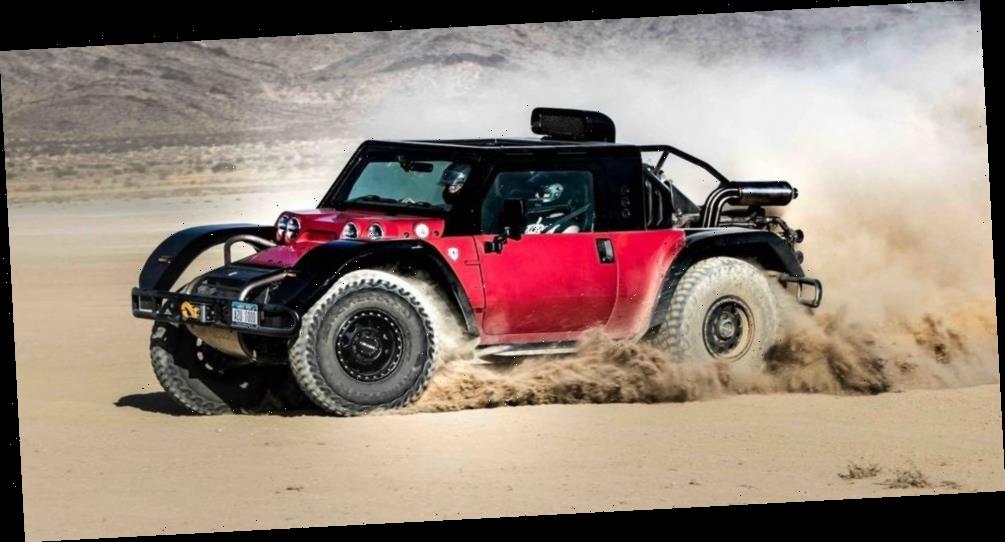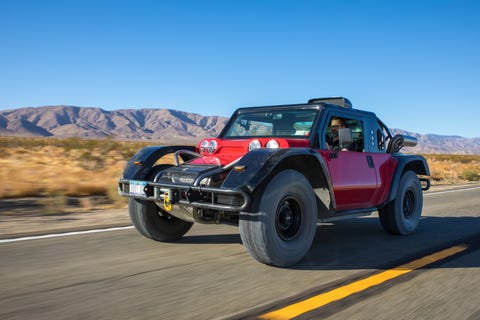As an auditory experience, the Glickenhaus Boot is perhaps unique among road-going vehicles. The massive off-road tires of this dessert-running beast hum against the pavement. There are no side windows in this prototype, so the wind at 90 mph means conversations are of the vocal-cord-straining variety. From behind comes the burble of a modern small-block Chevy V-8 overlaid with the whine of a massive supercharger. The straight-cut gears of its race-ready four-wheel-drive transfer case wail away, sometimes drowning out all other noise. After a few minutes and several full-throttle pulls, there’s a weird resonance in my ears that makes me feel like I have water trapped in my canals. When my brief road drive is done, the silence of the Southern California desert feels oppressive and disorienting.
In other words, the experience behind the wheel of this reborn desert racer is all kinds of awesome.
Glickenhaus
And how could it not be? Take a look at the thing. It’s a massive four-eyed scarab. It’s a cartoon come to life. Out here in Johnson Valley, about 50 miles from Joshua Tree National Park, the Boot’s bright red body positively blares against the dung-colored mountains and nutrient-free, buff-hued dust of the desert floor. Were it not for its vibrant color, you could be convinced that the Boot is a military vehicle. It has a purposeful, no-frills look and, from a distance, you could mistake the high-mounted exhausts for twin Gatling guns. It’s too bulky to look quite like a desert-racing buggy. It’s too weird to bear a meaningful resemblance to any SUV you’ve ever seen, unless you regularly hallucinate two-seat SUVs with partly exposed rear engines and effectively no front bodywork. So, what the hell is this thing?
Well, it’s a sort of replica. It’s sort of a racing rig. And, if its creators have their way, it’ll be a widely available, pricey, and street-able SUV in the mold of the Lamborghini LM002 from the 1980s. It’s the brainchild of noted automotive collector, former movie producer, race-car constructor, and nascent street-car maker Jim Glickenhaus. He has a certain fascination with re-birthing automotive legends. And he has the money to make it happen. You might recognize Glickenhaus as the man who, 14 years ago, commissioned Pininfarina to design for him a Ferrari Enzo-based, road-going modern interpretation of the old 1960s Ferrari sports racers, called the P4/5. Even his son Jesse, who is in charge of the Boot project, looks like a new version of his father. They wear similar Stetson hats and the identical light-blue Scuderia Cameron Glickenhaus jacket.
Glickenhaus
Something Old, Something New
Let’s start at the beginning. Back in 1967, a General Motors engineer by the name of Vic Hickey designed a low-slung, four-wheel-drive buggy with a mid-mounted GM V-8 and effectively no front end. The vehicle was built in Detroit by Hurst to race in the inaugural Baja 1000 (then called the Mexico 1000). Before the 1968 race, this vehicle called the Boot was purchased and raced by noted race buff Steve McQueen. Glickenhaus purchased the original Boot at auction in 2010. Smitten with it, he decided to commission a modern version that could be driven to Ensenada, Mexico, for the Baja 1000, compete in the race, and then drive home. The idea eventually expanded to include the manufacture of Boots to sell to well-heeled enthusiasts. The starting price of the two-door model will be more than $250,000; a planned four-door model will cost more.
We got an exclusive first drive of the prototype road-going Boot during one of the team’s testing sessions, as they readied their racing version for the upcoming 52nd running of the Baja 1000. That team consists of Jim and Jesse Glickenhaus, experienced desert racer and project lead Darren Skilton, and the guys from Armada Engineering who are actually building the Boot in Chatsworth, California.
Glickenhaus
The Glickenhaus Boot, like its inspiration, is a purpose-built thing, not some up-fitted version of an existing SUV. Its structure is a chromoly and mild-steel tube-frame chassis that sprouts independent front and rear suspensions composed of a spider’s web of long tubular-steel links. At the end of the links are mounted 17-inch Method Race beadlock wheels wearing massive 39.0-inch-tall BFGoodrich Mud Terrain T/A KM3 tires. It has 19.0 inches of wheel travel front and rear and is fitted with fat, internal-bypass Fox coil-over dampers. Weighing in at about 5550 pounds, this is one stoutly built two-seater. At 85.0 inches wide, the Boot is slightly broader than the massive old military Humvee.
The prototype is powered by a 650-hp 6.2-liter LT4 GM crate engine, turned 180 degrees and mounted in the tail. That’s bolted to a GM four-speed 4L80E automatic transmission. Most road-going Boots will be powered instead by naturally aspirated LT1 or LT2 V-8s, making at least 460 horsepower. Glickenhaus is correct in stating that the LT4 is “not really necessary.” The roof-mounted scoop feeds cooling air to a radiator slotted between the engine and the passenger cabin.
Glickenhaus
Roads Are Optional
With the LT4, the Boot is a fast thing. We unintentionally hit 90 mph moments after strapping into its five-point harness. So massive is the Boot (and so empty is the desert) that speed and the sensation of speed are irreconcilably divorced. We were genuinely surprised by our pace when we swiped the dust off the Motec digital display that serves as the Boot’s gauges. The Boot is still very much a work in progress. The side mirrors and stereo cannot handle the jostling the Boot delivers off-road. On the road, the steering ratio is a little too quick, so we had to be slow and deliberate with our inputs to prevent the softly suspended Boot from wobbling from side to side. But that’s what development and testing is for. As a proof of concept, the Boot is already damn impressive, even on pavement.
On the nasty, lumpy trails of Johnson Valley, the Boot is truly at home. It’ll cover deeply rutted, hillock-covered desert ground in excess of 50 mph without breaking a sweat. Its wheels chug up and down taking the abuse but leaving the body to mostly float above the violence. It’ll power over nasty rock climbs. Crawl over boulders with careful wheel placement and the help of spotters? Hell no, you can just launch the thing. Its underbody is essentially one large skid plate. Try that with your Mercedes-AMG G63.
Glickenhaus
The version of the Boot that will compete in the upcoming Baja 1000 is even more capable, with an additional few inches of wheel travel and heavy-duty boxed-steel suspension arms. We rode with Skilton when he pushed the race Boot to 102 mph. That the race version is powered by a 460-hp LT1 V-8 provides further proof that the supercharged engine is not really necessary.
Surely, there is taming left to be done before the wild and wooly Boot is ready to ferry its wealthy patrons in the real world. But it is a unique proposition in the vehicular world. And it is awesome.
From: Car and Driver
Source: Read Full Article





